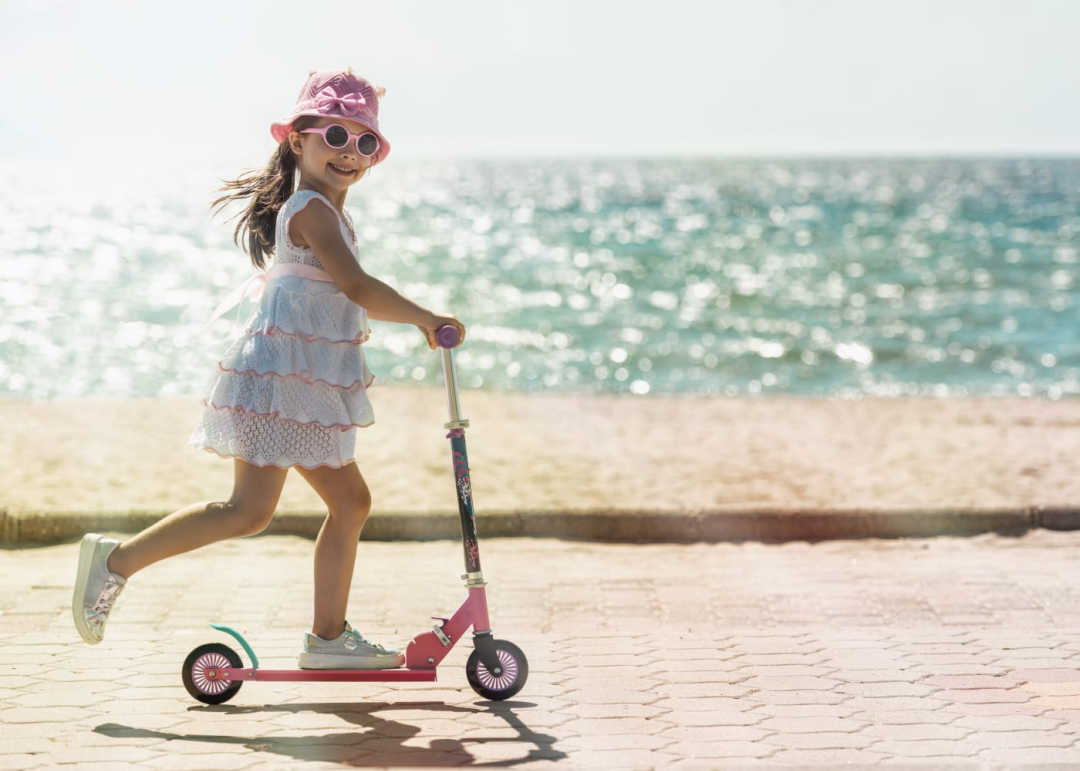As a parent, your child’s safety is your top priority – especially on the road. Children are fearless – falls, scraped knees, bumps and bruises are all part of being a kid, but these accidents can become more serious when they’re riding a bike or scooter.
From using proper safety equipment to respecting the rules of the road, let’s take a look at the key things you need to consider to ensure your child has the best (and safest) scooter riding experience.
#1 – Protective Gear
Step one: never skip the safety gear. Here are the essentials for your child’s scooter safety.
Helmets
A helmet is the most important piece of safety gear to protect your child against serious head injuries when riding scooters.
How to find the safest helmet for scooters:
- Check for the Australian Standards approved label.
- Let your child try the helmet on to make sure it fits properly before you buy it.
- You can do the ‘push test’ to see if the helmet is a snug fit. It’s too big if you can push the helmet sideways, backwards, or forwards after you’ve clipped it.
- Avoid buying second-hand helmets – there’s no way of knowing if was damaged in an accident by the previous user.
- Bonus tip: Always make sure you replace the helmet after an accident.
Wrist Guards, Knee And Elbow Pads
Common injuries among scooter riders include wrist fractures. Most people instinctively put their hands out to save themselves when falling off. Therefore, invest in a decent pair of wrist guards, knee pads, and elbow pads so that your child is fully protected from falls.
#2 – Scooter Checklist
Cheaper scooters might come with hazardous design flaws – such as flimsy folding mechanisms that can give way under pressure, or dangerously sharp edges that lead to injuries.
Steer clear from cheaply made scooters and pick a design that matches your child’s size and motor skills. If you want the best for your child, it’s recommend you go for a reliable, good quality kick scooter.
Things to look for in a safe scooter:
- Look for solid brakes – check the brakes regularly because they’ll wear down over time.
- Avoid scooters with sharp pieces, or sharp edges.
- Check that the steering bar locks into place easily, and won’t collapse.
- The handlebars should be at a comfortable height for your child.
- The handlebar grips must not swivel.
- Check that the running board is high off the ground.
- Make sure there is an anti-skid footboard.
- A bell or horn is an awesome safety addition.
#3 – Road Safety
Introducing your child to the road can seem scary, but teaching them to follow simple road safety rules ensures they are riding safely.
Key road safety tips for kids:
- Start by riding in a safe learning area (like a quiet road, or a dead-end street) while your child is mastering the skills to ride a scooter.
- Make it a habit for your child to always wear their safety equipment every time they go for a ride – even in the garden.
- Make sure you (or another adult) is always there to supervise your child when riding a scooter.
- Never allow a young child to ride their scooter near the street.
- Only allow an older child to ride their scooter near the road when they are proficient at riding and responsible.
- Teach your child how to abide by the rules of the road, and check their understanding.
- Dress your child in brightly coloured clothes so that they are clearly visible to drivers on the road.
- Remind your child of the potential dangers and the importance of scooter safety.
#4 – What Age Is Appropriate For Riding A Scooter?
Generally, children have different levels of motor ability. Therefore, it depends entirely on the child whether they are ready and able to ride a kick scooter. Some kids begin riding a scooter anywhere from the age of two. Needless to say, you shouldn’t let your two-year-old ride anywhere but the backyard.
According to child safety experts, it’s inappropriate for any child under eight years of age to ride a scooter near the road. And, because this toy is typically lightweight and may be motorised, it can travel at fast speeds. For the safest experience, parents should supervise their children and insist that safety equipment is used at all times – no matter their age.


No Comments